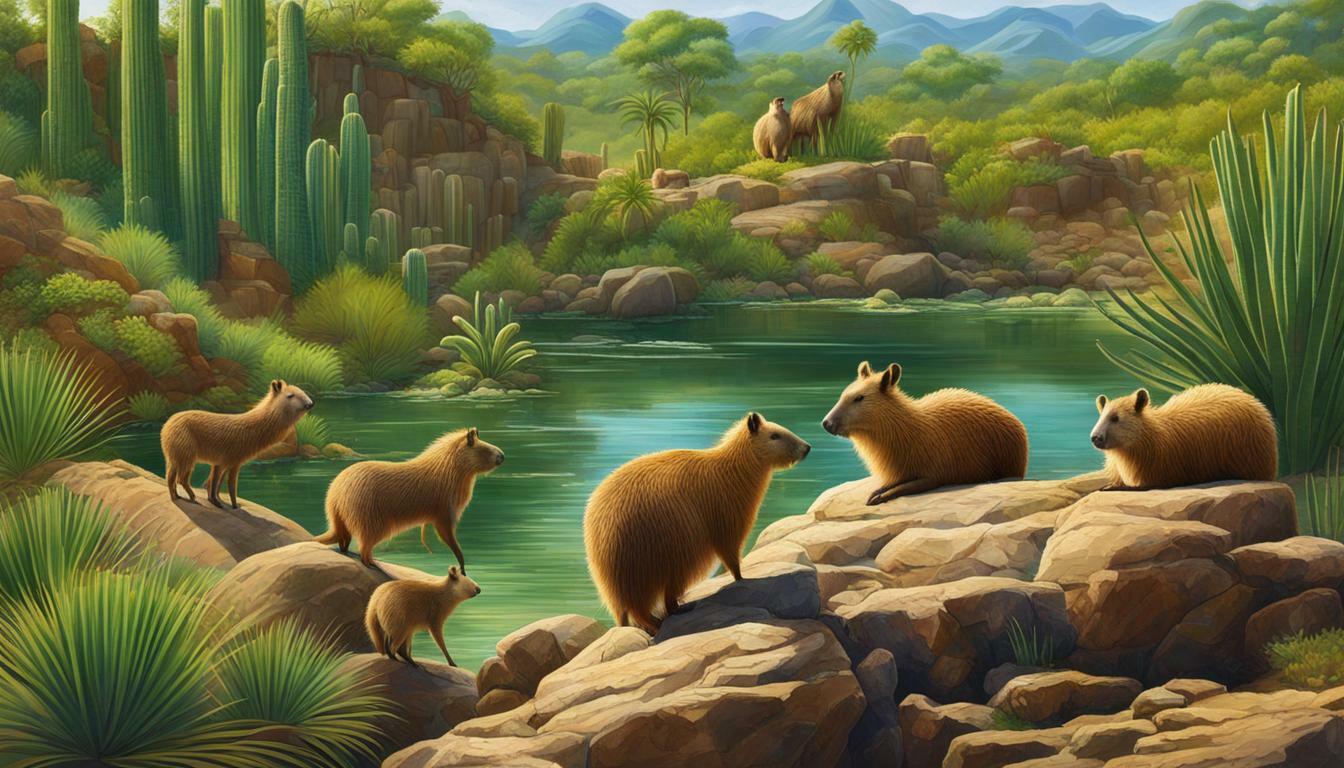Mexico is known for its diverse wildlife, but are capybaras one of the species that can be found in this country?
Capybaras, the largest rodents in the world, are typically found in South America. They inhabit countries such as Brazil, Venezuela, Colombia, Ecuador, Peru, Bolivia, Uruguay, and Argentina. Despite their absence as native species in Mexico, there have been occasional reports of capybaras being spotted in the country. However, it is uncertain whether they have established a breeding population or if their presence is temporary.
It is important to note that the Mexican agouti, a closely related species, is native to Mexico and can sometimes be mistaken for capybaras. While agoutis share some similarities with capybaras, such as their appearance and behavior, they are distinct animals with their own unique characteristics.
Capybaras are semi-aquatic animals and prefer to live in areas with access to water. They thrive in wetlands, marshes, and forested regions near rivers, lakes, or ponds. These habitats provide the ideal conditions for capybaras to feed on aquatic vegetation and swim, which are essential aspects of their daily lives.
Key Takeaways:
- Capybaras are not native to Mexico and are commonly found in South American countries.
- There have been sporadic sightings of capybaras in Mexico, but their presence as a breeding population is uncertain.
- The Mexican agouti, a closely related species, is native to Mexico and can be mistaken for capybaras.
- Capybaras prefer semi-aquatic environments and thrive near bodies of water.
- Mexico’s diverse wildlife includes various species, but capybaras are not typically among them.
Capybara Distribution in South America
Capybaras are native to South America and can be found in countries such as Brazil, Venezuela, Colombia, Ecuador, Peru, Bolivia, Uruguay, and Argentina. These impressive creatures are well adapted to the diverse environments of their natural habitat, which includes wetlands, savannas, and forests.
As the largest rodent in the world, capybaras are remarkable for their size, reaching up to 4 feet in length and weighing as much as 150 pounds. They are social animals and live in large groups, known as herds, that can consist of 20 to 100 individuals. Capybaras are particularly well-suited for their semi-aquatic lifestyle, with their webbed feet enabling them to be excellent swimmers.
Within South America, capybara populations are widespread, and their numbers remain relatively stable in their native range. These animals are herbivores, primarily feeding on grasses and aquatic plants. Their ability to thrive in various habitats has contributed to their success across the continent, as they can adapt to both the lush rainforests of the Amazon basin and the drier grasslands of the Pampas.
| Country | Estimated Capybara Population |
|---|---|
| Brazil | 1,000,000+ |
| Venezuela | 10,000+ |
| Colombia | 5,000+ |
| Ecuador | 2,000+ |
| Peru | 1,500+ |
| Bolivia | 1,000+ |
| Uruguay | 500+ |
| Argentina | 200+ |
While capybaras are not native to Mexico, there have been occasional reports of sightings in the country. However, it remains unclear if these sightings represent established breeding populations or are merely individual animals that have strayed from their natural range. It’s important to note that the native Mexican agouti, which is similar in appearance to capybaras, can sometimes be mistaken for them.
In South America, capybaras have become an iconic species, representing the unique biodiversity of the continent. Their adaptability and ecological role as herbivores contribute to the balance of ecosystems they inhabit. While they may not be found in Mexico, their continued protection and conservation efforts in their native range are crucial to ensure their long-term survival.
Capybaras and the Mexican Agouti
While capybaras are not native to Mexico, there have been reports of sightings in the country, although it is uncertain if they have established a breeding population. It is important to note that the Mexican agouti, a closely related species, is native to Mexico and can sometimes be mistaken for capybaras.
The capybara, known as the world’s largest rodent, is primarily found in South America, particularly in countries such as Brazil, Venezuela, Colombia, Ecuador, Peru, Bolivia, Uruguay, and Argentina. These semi-aquatic animals are well-adapted to live in areas with access to water, making them excellent swimmers and divers.
It is possible that capybaras in Mexico could be introduced or escaped individuals from captivity, rather than a wild population. Without evidence of successful breeding, it is challenging to determine if capybaras have become established in the country. Ongoing research and documentation efforts are necessary to provide a more definitive answer.
| Capybara Facts: | Mexican Agouti Facts: |
|---|---|
| Capybaras are herbivores that primarily feed on grasses and aquatic vegetation. | Mexican agoutis have a similar diet and also consume fruits, nuts, and seeds. |
| Capybaras are highly social animals that live in groups called “herds” or “troops”. | Mexican agoutis are more solitary, typically living alone or in pairs. |
| Capybaras have webbed feet, which make them excellent swimmers. | Mexican agoutis have smaller, non-webbed feet and are not as well adapted for swimming. |
“The presence of capybaras in Mexico, if confirmed, could have significant implications for the country’s ecosystem. It would require proactive measures to monitor their population and mitigate any potential ecological impacts.”
As Mexico is home to a diverse range of wildlife, the presence of capybaras, even in small numbers, could have both positive and negative effects on the local ecosystem. Capybaras are known to create and maintain wetland habitats, which can benefit other species, but they may also compete for resources with native wildlife.
In conclusion, while capybaras are not native to Mexico, there have been reports of sightings in the country. The presence of the Mexican agouti adds an additional layer of complexity to the situation, as they can sometimes be mistaken for capybaras. Further research and observation are necessary to determine if capybaras have established a breeding population in Mexico and to assess their potential ecological impacts.
Capybara Habitat Preferences
Capybaras thrive in areas with abundant water sources, such as rivers, lakes, and marshlands, making them well-suited to a variety of habitats. Due to their semi-aquatic nature, capybaras are often found in regions with a humid climate, where they can easily access water for drinking, bathing, and escaping from predators.
These water-loving creatures are excellent swimmers and are known to spend a significant amount of time in the water. They have webbed feet and eyes and nostrils positioned high on their heads, enabling them to navigate through aquatic environments efficiently. Capybaras are herbivores and feed on a diet primarily consisting of grasses and aquatic plants, which are readily available in their preferred habitats.
While capybaras are native to South America, there have been sightings of these fascinating creatures in Mexico. However, it is unclear whether they have established a breeding population in the country. It is important to note that capybaras and the Mexican agouti, a closely related species, can sometimes be mistaken for one another. The Mexican agouti is native to Mexico and can be found in forested areas, whereas capybaras prefer open grasslands near water bodies.
| Preferred Habitat | Features |
|---|---|
| Rivers | Capybaras are often seen near riverbanks, where they can easily access water for drinking and cooling off. |
| Lakes | They are known to inhabit areas surrounding lakes, where they can graze on vegetation and take refuge in the water when needed. |
| Marshlands | Capybaras are well-suited to marshy areas, where they can find an abundance of aquatic plants to feed on. |
“Capybaras are fascinating creatures that have adapted to thrive in various habitats, particularly those with ample water sources. Their ability to swim and their preference for a herbivorous diet make them ideal residents of wetland areas. While there have been reports of capybaras in Mexico, it is essential to differentiate them from the native Mexican agouti to accurately assess their population in the country.” – Wildlife expert
Wildlife Conservation Efforts in Mexico
Mexico has implemented various conservation programs to protect its unique wildlife, including efforts to preserve natural habitats and prevent the introduction of non-native species. These initiatives aim to maintain the country’s rich biodiversity and ensure the survival of its native flora and fauna. While capybaras are not native to Mexico, these conservation efforts play a crucial role in safeguarding the country’s ecosystems.
Through the establishment of protected areas and national parks, Mexico has created safe havens for its diverse wildlife. These protected areas help to conserve the natural habitats that support a wide range of species, including endangered and threatened ones. By preserving these habitats, Mexico not only protects its native wildlife but also contributes to global biodiversity conservation.
In addition to habitat preservation, Mexico has also implemented measures to control the introduction of non-native species. This is important because the introduction of invasive species can disrupt ecosystems and threaten native flora and fauna. The Mexican government works to prevent the establishment of non-native species, ensuring the ecological balance is maintained.
Conservation Programs in Action
One example of Mexico’s conservation efforts is the Biosphere Reserve of Calakmul, located in the Yucatan Peninsula. This reserve is home to a diverse range of species, including jaguars, howler monkeys, and tapirs. By protecting this area, Mexico preserves the habitat of these animals and allows them to thrive. Furthermore, the reserve serves as a research and education center, promoting awareness and understanding of wildlife conservation.
“The conservation of Mexico’s unique wildlife is crucial for maintaining the ecological balance and preserving the country’s natural heritage.” – Dr. Maria Fernandez, Wildlife Biologist
Mexico’s commitment to wildlife conservation extends beyond its borders. The country actively collaborates with international organizations and participates in global initiatives to protect endangered species and conserve natural habitats. These partnerships allow Mexico to share knowledge and resources, contributing to the collective effort of safeguarding the planet’s biodiversity.
| Conservation Initiatives | Description |
|---|---|
| Protected Areas | Mexico designates protected areas, such as biosphere reserves and national parks, to safeguard natural habitats and support biodiversity. |
| Invasive Species Control | The Mexican government implements measures to prevent the introduction of non-native species, protecting native fauna and flora. |
| International Collaboration | Mexico actively engages in partnerships with international organizations to contribute to global wildlife conservation efforts. |
By prioritizing wildlife conservation, Mexico takes proactive steps to protect its unique ecosystems and the species that call them home. These efforts not only benefit the country’s wildlife but also contribute to the global conservation of biodiversity.
Capybaras in Mexican Culture and Tourism
Capybaras have become a popular attraction for tourists visiting certain regions of Mexico, showcasing the country’s rich biodiversity. These fascinating creatures, although not native to Mexico, have captured the imagination of both locals and visitors alike. Many nature enthusiasts and animal lovers are drawn to Mexico’s lush landscapes in the hopes of catching a glimpse of these unique semi-aquatic mammals.
In certain areas of Mexico, such as the Yucatan Peninsula and the Sian Ka’an Biosphere Reserve, capybara spotting has become a sought-after activity. Tourists enjoy embarking on guided tours and wildlife excursions to observe these gentle giants in their natural habitat. The presence of capybaras not only adds to the allure of Mexico’s natural attractions but also contributes to the country’s efforts in promoting eco-tourism.
Capybaras: A Cultural Symbol
Aside from their appeal to wildlife enthusiasts, capybaras have also made their mark in Mexican culture. These sociable animals have found their way into local folklore and traditions, becoming a symbol of resilience and adaptability. They have been featured in indigenous artwork, literature, and even regional festivals, where costumed performers mimic their distinct behavior.
Moreover, capybaras play a significant role in promoting environmental awareness and conservation in Mexico. Through educational programs and initiatives, locals and tourists alike are educated about the importance of preserving the natural habitats where capybaras and other vulnerable species thrive. By appreciating these fascinating creatures, visitors develop a deeper appreciation for Mexico’s diverse ecosystems and become more invested in their protection.
As Mexico continues to promote sustainable tourism and wildlife conservation, capybaras serve as a reminder of the country’s commitment to preserving its natural heritage. Whether you encounter them in the wild or explore their cultural significance, capybaras offer a memorable and enriching experience for those who venture into Mexico’s remarkable natural wonders.
| Region | Popular Capybara Spots |
|---|---|
| Yucatan Peninsula | Sian Ka’an Biosphere Reserve |
| Mexico City | Chapultepec Park |
| Veracruz | Catemaco Lake |
Ecological Impacts of Capybaras in Mexico
If capybaras were to successfully establish themselves in Mexico, they could potentially impact local ecosystems through their feeding habits and competition with native species. These large rodents are known to be voracious eaters, consuming a wide variety of vegetation, including grasses, aquatic plants, and crops. Their grazing activities can have a significant effect on the vegetation in their habitat, potentially altering the composition and structure of plant communities.
Capybaras’ feeding habits could also lead to increased soil erosion in areas where they establish populations. As they graze on vegetation near bodies of water, their movement and consumption of plants can result in the degradation of stream banks and riverbeds. This can lead to increased sedimentation and changes in water flow dynamics, affecting the overall health of aquatic ecosystems.
Furthermore, the introduction of capybaras to Mexico could potentially disrupt the balance of local wildlife populations. Capybaras are highly adaptable and can compete with native species for resources such as food and habitat. This competition can negatively impact smaller mammals and herbivores, potentially leading to shifts in species abundance and distribution. Additionally, capybaras can serve as hosts for various parasites and diseases that could affect both wildlife and domestic animals in Mexico.
| Potential Ecological Impacts of Capybaras in Mexico |
|---|
| Altered vegetation composition and structure |
| Increased soil erosion |
| Disruption of wildlife populations through competition |
| Potential spread of parasites and diseases |
It is crucial to implement effective wildlife management and conservation measures to prevent the negative ecological impacts that capybaras could have in Mexico. These efforts could involve monitoring capybara populations, implementing control measures in case of established populations, and raising awareness among local communities and stakeholders about the potential risks associated with these non-native species.
Capybara Research and Conservation Initiatives in Mexico
Scientists and conservationists in Mexico are actively studying capybaras to better understand their behavior, habitat requirements, and potential impact on local ecosystems. These initiatives aim to gather valuable data that can inform future conservation efforts and help protect Mexico’s biodiversity. Here are some key research and conservation projects currently underway:
1. Capybara Distribution Surveys
Researchers are conducting extensive distribution surveys across different regions of Mexico to determine the presence and abundance of capybaras. These surveys involve field observations, camera trapping, and collection of fecal samples for genetic analysis. By mapping the distribution of capybaras, scientists can identify areas that require conservation attention and implement targeted conservation measures.
2. Habitat Assessment and Restoration
Understanding the habitat preferences and requirements of capybaras is essential for their conservation. Researchers are studying the specific habitat characteristics that capybaras prefer, such as the availability of water bodies and suitable vegetation. This information helps identify crucial habitats that need protection and aids in habitat restoration efforts to ensure capybaras have suitable habitats for their survival.
3. Monitoring Population Dynamics
Monitoring the size and growth of capybara populations is vital for assessing their conservation status. Researchers are using various techniques, including camera traps and mark-recapture methods, to estimate population sizes, birth rates, and survival rates. By monitoring these population dynamics, conservationists can identify any declines or threats to capybara populations and implement appropriate conservation actions.
| Research Initiative | Description |
|---|---|
| Capybara Distribution Surveys | Field surveys, camera trapping, and genetic analysis to map capybara distribution in Mexico. |
| Habitat Assessment and Restoration | Studying habitat preferences and implementing habitat restoration measures for capybaras. |
| Monitoring Population Dynamics | Using camera traps and mark-recapture methods to estimate population sizes and assess conservation status. |
These research and conservation initiatives contribute to the overall understanding of capybaras in Mexico and help guide effective conservation strategies. By prioritizing the protection of capybaras and their habitats, Mexico can ensure the long-term survival and well-being of these unique and fascinating animals.
Capybaras and their Unique Traits
Capybaras are the largest rodents in the world, known for their social nature and their ability to communicate through a variety of vocalizations. These fascinating animals have several unique traits that set them apart from other species.
One notable characteristic of capybaras is their semi-aquatic lifestyle. They are excellent swimmers and are often found in and around bodies of water such as rivers, lakes, and marshes. Their webbed feet and streamlined bodies make them agile in the water, allowing them to escape potential predators or seek refuge. Capybaras also have a special gland that produces an oily secretion, which helps to waterproof their fur and keep them buoyant.
Another remarkable aspect of capybara behavior is their strong social structure. They live in groups called herds, which can consist of up to 100 individuals. These social units are typically led by a dominant male and include several females and their offspring. Capybaras engage in communal activities such as grooming, sunbathing, and foraging, reinforcing their bonds and ensuring the well-being of the group. Their cooperative nature extends beyond their own species, as they often form symbiotic relationships with birds that feed on parasites found in their fur.
Capybaras are herbivores, primarily feeding on grasses and aquatic plants. Their constant grazing helps to shape and maintain their habitat, benefiting other species in their ecosystem. They have a unique digestive system that allows them to efficiently break down tough plant materials, making them essential contributors to the local food chain.
| Unique Traits of Capybaras | |
|---|---|
| 1. Semi-aquatic lifestyle | Capybaras are excellent swimmers and thrive in aquatic environments. |
| 2. Strong social structure | They live in herds and engage in communal activities, reinforcing social bonds. |
| 3. Herbivorous diet | Capybaras primarily feed on grasses and aquatic plants, contributing to ecosystem balance. |
Overall, capybaras are remarkable creatures with unique traits that make them a fascinating subject of study and observation. While they are not native to Mexico, reports of their presence in the country have sparked interest and further research. Understanding the behavior and ecological importance of capybaras contributes to our knowledge of these charismatic animals and their potential impact on different ecosystems.
Conclusion
While capybaras are not native to Mexico, there have been occasional sightings of these unique creatures, contributing to the country’s rich biodiversity. Capybaras are typically found in South America, with populations in countries such as Brazil, Venezuela, Colombia, Ecuador, Peru, Bolivia, Uruguay, and Argentina. However, there have been reports of capybaras being spotted in Mexico, although it remains uncertain if they have established a breeding population.
It’s important to note that the Mexican agouti, a closely related species, is native to Mexico and can sometimes be mistaken for capybaras. These two species share similar physical characteristics, but capybaras are generally larger in size. Additionally, capybaras are semi-aquatic animals and prefer habitats with access to water, such as rivers, lakes, and marshes.
As Mexico prioritizes wildlife conservation, it is crucial to monitor the presence of capybaras and their potential impact on the local ecosystem. Ongoing research and conservation initiatives specifically focused on capybaras are necessary to ensure the proper management and protection of these fascinating creatures.
Despite their non-native status, occasional sightings of capybaras in Mexico serve as a reminder of the interconnectedness of ecosystems and the diversity of wildlife. While their presence may be rare, these sightings allow for the appreciation and study of capybaras, enhancing our understanding of their behavior and ecological role.
FAQ
Are there capybaras in Mexico?
Capybaras are not native to Mexico and are typically found in South America. However, there have been some reports of capybaras being spotted in Mexico, although it is not known if they have established a breeding population.
Where are capybaras usually found?
Capybaras are primarily found in countries such as Brazil, Venezuela, Colombia, Ecuador, Peru, Bolivia, Uruguay, and Argentina.
How can capybaras be identified in Mexico?
Capybaras can sometimes be mistaken for the Mexican agouti, a closely related species native to Mexico.
What kind of habitat do capybaras prefer?
Capybaras are semi-aquatic animals and prefer to live in areas with access to water.




